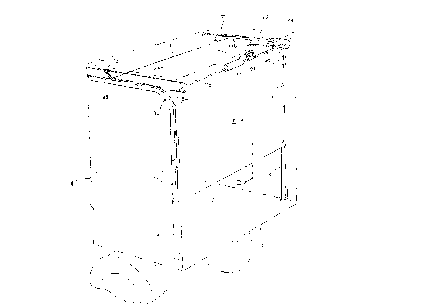Une partie des informations de ce site Web a été fournie par des sources externes. Le gouvernement du Canada n'assume aucune responsabilité concernant la précision, l'actualité ou la fiabilité des informations fournies par les sources externes. Les utilisateurs qui désirent employer cette information devraient consulter directement la source des informations. Le contenu fourni par les sources externes n'est pas assujetti aux exigences sur les langues officielles, la protection des renseignements personnels et l'accessibilité.
L'apparition de différences dans le texte et l'image des Revendications et de l'Abrégé dépend du moment auquel le document est publié. Les textes des Revendications et de l'Abrégé sont affichés :
| (12) Demande de brevet: | (11) CA 2185080 |
|---|---|
| (54) Titre français: | PORTE A ENROULEMENT VERTICAL |
| (54) Titre anglais: | ROLL UP DOOR |
| Statut: | Réputée abandonnée et au-delà du délai pour le rétablissement - en attente de la réponse à l’avis de communication rejetée |
| (51) Classification internationale des brevets (CIB): |
|
|---|---|
| (72) Inventeurs : |
|
| (73) Titulaires : |
|
| (71) Demandeurs : |
|
| (74) Agent: | SMART & BIGGAR LP |
| (74) Co-agent: | |
| (45) Délivré: | |
| (22) Date de dépôt: | 1996-09-09 |
| (41) Mise à la disponibilité du public: | 1998-03-10 |
| Licence disponible: | S.O. |
| Cédé au domaine public: | S.O. |
| (25) Langue des documents déposés: | Anglais |
| Traité de coopération en matière de brevets (PCT): | Non |
|---|
| (30) Données de priorité de la demande: | S.O. |
|---|
Cette invention concerne une porte à enroulement vertical destinée à fermer l'arrière d'une caisse de camion, ladite porte étant composée d'une pluralité de lattes jointives sur la face extérieure desquelles est collée une feuille souple mince. De l'autre côté, chaque paire de lattes adjacentes est reliée par un ruban souple. Chacune des lattes porte un galet à ses deux extrémités qui circule dans un chemin de roulement ayant la forme générale d'un L inversé. Grâce à cette disposition, les lattes peuvent s'incliner lorsque les galets correspondants passent de la partie verticale à la partie horizontale du chemin de roulement, les courroies se plissant à la manière d'un soufflet et permettant à la feuille de revêtement extérieur de plier également.
A roll up door which may be used in the back of a van
body comprises a plurality of panels arranged edge-to-edge with
a thin flexible sheet glued to the outside face of the panels
and a flexible belt attached to each pair of adjacent panels at
the rear face of these panels. A roller extends from each end
of each panel and is received by a generally inverted L-shaped
guide track. With this arrangement, the panels may cant while
moving from the vertical to the horizontal leg of the guide
channels by virtue of the belts which hinge and collapse
allowing the outer sheet to bend as well.
Note : Les revendications sont présentées dans la langue officielle dans laquelle elles ont été soumises.
Note : Les descriptions sont présentées dans la langue officielle dans laquelle elles ont été soumises.

2024-08-01 : Dans le cadre de la transition vers les Brevets de nouvelle génération (BNG), la base de données sur les brevets canadiens (BDBC) contient désormais un Historique d'événement plus détaillé, qui reproduit le Journal des événements de notre nouvelle solution interne.
Veuillez noter que les événements débutant par « Inactive : » se réfèrent à des événements qui ne sont plus utilisés dans notre nouvelle solution interne.
Pour une meilleure compréhension de l'état de la demande ou brevet qui figure sur cette page, la rubrique Mise en garde , et les descriptions de Brevet , Historique d'événement , Taxes périodiques et Historique des paiements devraient être consultées.
| Description | Date |
|---|---|
| Inactive : CIB désactivée | 2015-01-24 |
| Inactive : CIB expirée | 2015-01-01 |
| Inactive : CIB attribuée | 2015-01-01 |
| Inactive : CIB de MCD | 2006-03-12 |
| Inactive : CIB de MCD | 2006-03-12 |
| Inactive : CIB de MCD | 2006-03-12 |
| Le délai pour l'annulation est expiré | 2000-09-11 |
| Demande non rétablie avant l'échéance | 2000-09-11 |
| Inactive : Page couverture publiée | 1999-09-30 |
| Réputée abandonnée - omission de répondre à un avis sur les taxes pour le maintien en état | 1999-09-09 |
| Demande publiée (accessible au public) | 1998-03-10 |
| Date d'abandonnement | Raison | Date de rétablissement |
|---|---|---|
| 1999-09-09 |
Le dernier paiement a été reçu le 1998-09-08
Avis : Si le paiement en totalité n'a pas été reçu au plus tard à la date indiquée, une taxe supplémentaire peut être imposée, soit une des taxes suivantes :
Veuillez vous référer à la page web des taxes sur les brevets de l'OPIC pour voir tous les montants actuels des taxes.
| Type de taxes | Anniversaire | Échéance | Date payée |
|---|---|---|---|
| TM (demande, 2e anniv.) - générale | 02 | 1998-09-09 | 1998-09-08 |
Les titulaires actuels et antérieures au dossier sont affichés en ordre alphabétique.
| Titulaires actuels au dossier |
|---|
| DIESEL EQUIPMENT LIMITED |
| Titulaires antérieures au dossier |
|---|
| JOHN C. MARTIN |